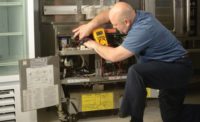According to the most recent report from Heating, Air-conditioning, and Refrigeration Distributors International (HARDI), average sales for its distributor members increased by by 12.2 percent in January 2017, and the average annualized growth fort he 12 months through January 2016 was 9.2 percent. According to HARDI, this is the strongest annual pace since 2011, when comparing against the end of The Great Recession.
“Pricing will, and likely already has, started to impact this number in a positive manner,” said Connor Lokar, senior economist, HARDI. “The U.S. Producer Price Index contracted throughout much of 2015 and all of 2016 but rose 1.8 percent on average during the last three months. Essentially every raw material [agricultural commodities not included] is in a rising price trend.”
LOOKING GOOD
“We’re cautiously optimistic about 2017,” said Chris Baker, president and CEO, Virginia Air, Richmond, Virginia. “Economic tailwinds combined with a business-friendly administration should hopefully accelerate the already forecasted nice growth in 2017. Now, we just need the weather to cooperate, but we haven’t quite figured out how to make that happen.”
Baker believes equipment sales will be strong this year, thanks to historically low interest rates, improving consumer confidence, and the quantity of older units that need to be replaced. “However, if the economy continues to improve, interest rates could become a headwind in future years. We do anticipate increased sales of new equipment this year, and, to a smaller degree, higher-efficiency equipment.”
Forecasted gross domestic product (GDP) growth combined with the recent stock market rally appear to have bolstered consumer confidence, which could make for a good year, said Tom Roberts, president, cfm Distributors Inc., Kansas City, Missouri, who also serves as president of HARDI.
“It remains to be seen if the pro-growth initiatives discussed by the incoming administration can be implemented relatively quickly,” he said. “If so, job growth and tax relief could reinforce consumer confidence and fuel higher growth rates.”
Improved confidence combined with more contractors taking advantage of training opportunities may also lead consumers to replace their aging HVAC equipment rather than repair it.
“Consumers and contractors are both incentivized by earlier replacement decisions; consumers gain increased comfort and efficiency and contractors earn higher sales volumes,” said Roberts. “While incremental operating cost savings are more difficult to monetize with higher base-system efficiencies, consumers’ options to upgrade to ECM [electronically commutated motor] technologies, variable-capacity systems, and increased IAQ options are clearly becoming more broadly understood by consumers and more effectively offered by our contractor customers. With a good economic backdrop, this should continue to positively drive the mix for distributors.”
Whether it’s up or down, being a business owner means that Larry Plocheck, president, Coastal HVAC Supply, Houston, is always concerned about the economy.
“I believe the HVAC industry is heading in the right direction, but I wouldn’t say we have turned a corner just yet,” he said. “In Houston, we are still feeling the effects of low oil prices and the layoffs from that industry. Residential, multifamily, and institutional markets here are growing because they aren’t overbuilt or vacant like the commercial and industrial segments, which have a ways to go to recover from the downturn in oil pricing.”
That being said, Plocheck believes new equipment sales will increase in 2017 as end users start replacing their equipment due to R-22 price increases. He anticipates sales will continue to be the strongest in mid-efficiency units and high-end IAQ accessories.
CONCERNS REMAIN
While feeling pretty good about 2017, distributors do have their share of concerns for the year.
“A tightening labor market, slowly rising interest rates, and a hefty federal infrastructure investment will present the opportunity for many young managers and leaders to learn how to deal with resurgent inflation, albeit a gentle impact at first,” said Roberts. “This will require more disciplined price increases as costs rise at intervals more frequently than annually and some overhead costs rise at outsized rates.”
Roberts is also concerned about the familiarity of equipment and systems brought about by higher minimum-efficiency standards, which has led to sales and marketing challenges.
“However, this has brought about a focus on those things that really matter in the distributor/contractor relationship and the contractor/consumer relationship,” he said. “Successful distributors will be persistent students of what these things really are.”
Controlling health insurance costs and managing the overtime rule are primary concerns for Plocheck.
“I’m optimistic that President Trump will make changes that will help all businesses have the ability to be successful and allow us to grow,” he said. “A new corporate tax structure should allow us to expand and spend more on training.”
But threats to traditional two-step distribution worry Plocheck, who is currently establishing online presence.
“This is going to be the new norm, so we, as distributors, must adapt to online sales or get left behind,” he said. “We’ve already dropped one manufacturer that chose direct sales.”
Baker is also concerned about disruptive changes occurring in the traditional HVAC sales channel.
“The prevalence and number of B2C [business to consumer] retailers of HVAC products on the web is astonishing and growing every day,” he said. “Those who think this will disappear or be stopped through regulation or other means should reconsider. However, there is still no significant technology or solution providing quality installed solutions, although people are trying. We believe that will be the real game changer.”
Baker said the biggest problem for the industry, at large, is finding, training, and keeping good people.
“This can also be our biggest opportunity, as companies that recruit and develop well will likely greatly outperform their competitors,” he said.
Publication date: 3/13/2017
Want more HVAC industry news and information? Join The NEWS on Facebook, Twitter, and LinkedIn today!











